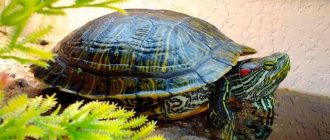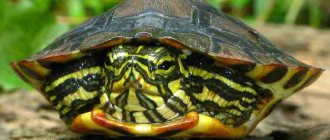The most interesting group of reptiles is rightfully the turtle. These amazing creatures can live both on the earth's surface and under water. Researchers who were engaged in archaeological excavations found that the turtle existed on earth 220 million years ago.
The diversity of turtle species includes common features.
Carapace
If you look at a photograph of a turtle, its main feature is its shell. This reliable device serves as a defense for the animal from external stimuli that pose a potential danger. It protects both from the back and the belly.
Sensing an approaching predator, the turtle can completely hide in it and remain out of reach. Experimentally, it was found that the shell can support a weight exceeding the mass of the reptile by 200 times.
Economic importance
Not too large land and aquatic turtles are popular pets that are highly valued by exotic lovers . Turtle meat is widely used for food purposes and is consumed raw, boiled or fried, and the unpretentiousness of such animals makes it easier to transport live reptiles as “live canned food.” The animal's shell is used in the manufacture of such traditional women's hair ornaments as kanzashi.
Most American states allow, but discourage, pets such as turtles, but Oregon does not allow such pets. It should also be noted that federal law in America completely prohibits the trade or transportation of turtles whose size is less than 100 mm, and in the western part of the country turtle racing, which is an original fair entertainment, is very popular.
Unlike many other well-known and studied reptiles, any turtle poses virtually no real threat to human life and health. The exception is represented by male leatherback turtles, who, with the onset of mating season, are able to grab swimmers with flippers or drown them, and biting and aggressive snapping turtles can inflict a serious bite on a person.
Video
Dimensions and weight
The turtle is a phenomenal reptile. Exceptional species grow up to 2 meters and weigh up to 1000 kilograms. But there are also small reptiles that weigh no more than 120 grams and grow up to 10 cm.
Main characteristics
The name “turtle” comes from the Latin word “testa”, which means “brick” or “tile”. The Russian-language analogue has a similar meaning: it takes its roots from the Proto-Slavic word “cerpaxa” - “shard”.
A distinctive feature of all turtles, regardless of species, is their shell. The design of a turtle's shell is so strong that it can support the weight of another animal, up to two hundred times the weight of the turtle itself.
Now you understand why the turtle is so slow. Just imagine how hard it is to move around every day!
As a rule, the length of a turtle can reach two meters, and the weight of this reptile can reach up to a ton.
However, there are also smaller varieties, which are characterized by the following dimensions: 120 grams in weight and 10 centimeters in length.
Head
The turtle's head is oval-shaped with small dimensions, thanks to which it can quickly hide it in a “bunker” in case of danger. Also in nature there are reptiles whose heads do not fit into the “protective capsule”.
Note!
Car hammock for dogs. What it is?- Removal and cremation of animals
Cynologists - who are they?
Due to the peculiarities of the turtle's lifestyle, its eyes are positioned so that they can look under its paws. In marine reptiles, on the contrary, they are located higher and directed into the distance.
Types of land turtles
Such reptiles usually have a fairly high, convex shell; flat and flattened shells are rare. They also have very thick legs, like pillars. The fingers grow together, only small claws can move apart.
Their protruding parts (neck, head and paws) are most often decorated with scales and scutes. The size of these animals is in a large size range - from very small, from 12 cm in length, to huge, with a diameter of more than 1.5 m. Giant species live on the Galapagos, Seychelles and some other islands.
The saying “slow as a turtle” refers specifically to land reptiles. They are clumsy and very leisurely, they don’t even try to run away from the enemy, they simply hide in their “house”. Methods of protection and deterrence are hissing, like a snake, or sudden urination, and due to the capacity of the bladder, it is quite voluminous.
At least some animals may well be scared off. They live a long time. They usually eat plants of all kinds, but they need animal protein, so sometimes they swallow a couple of insects or invertebrates. They can go without water for a long time; they only need plant juice. But in those places where there is moisture, they try to drink enough. Consider the following types of land turtles :
1. Galapagos elephant tortoise . A real giant among land turtles, its size reaches 1.8 m and weight up to 400 kg. In addition, it is considered a recognized long-liver among vertebrates. In captivity, lifespans of up to 170 years have been recorded. It lives only on the islands whose name it bears (endemic to the Galapagos Islands).
The shell is light brown in color, and mossy lichens can grow on it over the years. The paws are large and squat, with dry skin and hard shields and scales. The carapace can be dome-shaped or saddle-shaped. This depends on the humidity of the climate - the more moisture, the higher the shell.
They feed on herbs, which are often poisonous to other animals, so meat is not recommended for food. This species has become endangered due to the development of agricultural areas; work is now underway to increase its numbers.
2. Elastic turtle . It has a flat and soft shell, formed from thin perforated bone plates. Therefore, if necessary, it can be compressed quite significantly compared to its usual dimensions. The spaces between the plates even allow you to see how the turtle breathes. Her homeland is Southern Kenya, and she also lives in Tanzania, on the northeastern coast. Prefers rocky areas of the foothills.
3. Wood turtle . Found exclusively in Canada and the northern United States. Considered a forest species. The color of the carapace is “wood-like”: gray, the protruding parts are brown-gray, the lower shield is yellow. Hence the name. They exhibit rare aggression during the breeding season. The male bites not only his rivals, but also his chosen girlfriend, trying to grab the softer parts. In winter they fall asleep. They have a mixed diet and are omnivores. They reproduce very slowly, so they risk disappearing from the face of the Earth.
4. Balkan tortoise . The carapace most often reaches 15-25 cm, rarely up to 30 cm. The upper shield has a shade of cinnamon and saffron, with dark charcoal spots. For young people it is a sunny shade, very bright, but over the years it loses its brightness and becomes darker. They are distinguished by the presence of a cone-shaped spike at the tip of the tail.
It should be noted that the western representatives are larger in size than the eastern ones. In general, their favorite habitat is the European Mediterranean (Italy, Romania, Bulgaria, a piece of Turkey and Spain, and some other islands in the sea).
5. Panther (or leopard) turtle . Its carapace is high, dome-shaped, the main shade is the color of yellow sand; in young turtles there is a noticeably pronounced, very dark pattern. Over the years it smoothes out. It lives in Africa, from Sudan to Ethiopia. Herbivore, but may, on occasion, “chew” an insect or other protein food.
6. Yellow-footed turtle (shabuti) , lives in the tropical forests of South America. The shell size is up to 60 cm, color from light to dark brown. The protruding parts are light gray. Leads a forest lifestyle and avoids open spaces. Slow, hardy, herbivorous.
7. Yellow-headed turtle (Indian oblong). It lives in northeast India, Burma, Vietnam, Laos, Thailand, Cambodia, the island of Sulawesi and the Malay Peninsula. Lives in dry forests and semi-deserts. The carapace scutes have concentric stripes, the color ranges from olive to brown, and the head is yellow. Featured on a Vietnam postage stamp.
8. Red-footed turtle (coal). A little-studied variety. The size of a tall carapace is up to 45 cm, sometimes up to 70 cm. It is painted jet black with yellow and orange spots, sometimes these spots are located in the center of the tubercles. The protruding parts of the body have a pattern of red and orange. There are also red stripes behind the eyes.
9. Radiant turtle . They have a shell of rare beauty - the carapace is very high, on a dark background there are regular geometric patterns of yellow color in the form of rays. It looks like gold embroidery on dark skin. Lives in Madagascar. Herbivorous, but does not refuse animal food on occasion.
10. Steppe tortoise or Central Asian . A land representative who settled the region of Central Asia. It feeds on plants, grass, melons, berries, and fruits. Does not consume animal food. They have a slow metabolism, this quality made it possible to choose them for research missions into space.
11. Mediterranean (Caucasian, Greek) turtle . In nature, it is represented over a fairly wide area. It has 20 subspecies, which settled in southern Europe and Asia, slightly captured the northern part of Africa and settled densely in the Black Sea region (Dagestan, Georgia, Armenia, Azerbaijan and the Russian coast of the Caucasus).
Their favorite climate is sunny and warm. Varieties may differ in size, but in general their length does not exceed 35 cm. The color can also vary, most often it is a shade of dark yellow with brown specks. They have a horny tubercle on the back of the thighs. There are 5 toes visible on the front paws, and spurs on the hind paws.
12. Egyptian tortoise . Resident of the Middle East. The yellow carapace is bordered by a dark edge. They are very small and compact compared to previous types. The size of their shell barely reaches 12 cm.
Teeth and tongue
A strong and durable beak allows turtles to bite and grind the food they consume. It contains rough tubercles that are used as teeth. Regarding what the turtle eats, they can be pointed, like a dagger, or with edges that closely resemble teeth.
The turtle's tongue is short because it is intended only for swallowing food and not for grasping it.
What does a turtle prefer to eat at home?
If you have a pet turtle, its nutrition, maintenance and care should resemble its natural lifestyle. Before adopting a pet, study what it eats in nature and during what periods it is active.
Young individuals, as a rule, consume 70 percent of live food (food worms, insects, small crustaceans). Growing up, they switch almost entirely to plant foods. Suitable for feeding:
- vegetables and their tops (tomatoes, peppers, pumpkin, carrots, and occasionally cucumbers);
- berries (strawberries, wild strawberries, watermelon);
- fruits (plums, peaches, apples, bananas).
Do not overfeed the animal! If you see that there is food left after feeding, be sure to remove it and subsequently reduce the portions.
If you have a turtle at home, caring for it must necessarily include cleaning the aquarium. Be especially attentive to leftover food: stale food can lead to intestinal upset, which will affect how many years a turtle lives at home.
Reproduction
For different species, the mating season begins individually for each, but has characteristic similarities. Females lay eggs in depressions in the ground and compact them with sand.
The number of eggs can range from 1 to 200 depending on the type of turtle. The incubation period varies from 2 to 3 months.
Types of land turtles
This group is the leader in the number of representatives. It includes 37 species of land representatives and 85 freshwater ones. Also, several small families of 1-2 species each can be classified as terrestrial reptiles. They all spread quite widely, occupying space within the tropical, subtropical and temperate zones of the Earth.
Mostly terrestrial turtles are represented by herbivores. They eat any plant food, with which they can receive additional moisture. Indeed, in many habitats of these animals there is usually an arid climate.
If there is a long hot period of drought, reptiles hibernate. They have a slow metabolism, which is why they can live for a long time, for example, up to 150 years or more. Let's look at the two largest families - land and freshwater turtles.
Rivalry
Males fight fiercely for the right to mate with a female. Land turtles hit their shells against each other so that the enemy ends up on their backs or runs away.
Sea representatives pursue their rivals and gain the upper hand with menacing blows of their strong beak, forcing competitors to leave the battlefield.
Sexual characteristics of a turtle
The sex of turtles is determined by appearance and behavior, since these animals do not have clear genital differences, and it is almost impossible to figure out the sex at first glance. However, males differ from females:
- according to the shape of the shell (in females it is more elongated);
- the lower part of the shell is slightly concave in males, flat in females;
- the tail of males is longer, wider and thicker, it is more curved down;
- according to the shape of the anus;
- in males, the claws of the front paws are slightly longer;
- a small notch in the shell in the tail area is present only in males;
- The behavior of males is characterized by activity.
In some species, gender, in addition to the indicated characteristics, is expressed by the color or shape of the head.
Interesting Facts
- It was turtles that were the first to fly around our moon, on board an experimental research probe launched by the Soviet Union back in 1968.
- Turtle meat is an expensive and delicious product in some cuisines around the world.
- Turtles are also present in heraldry, in the depiction of the coats of arms of some cities.
- Despite the fact that turtles do not pose a danger to humans, there are exceptions, for example, male leatherback turtles can confuse a swimmer with a female, grab them with their paws and drag them to the bottom.
- The sex of turtles in the egg is determined by the ambient temperature. At lower temperatures, males are born, at higher temperatures, females are born.
What to feed
You need to feed your reptile at least twice a day. The turtle's diet should be varied, complete and balanced. A lack of any nutrients in food can lead to various diseases of organs and systems. Also, the diet must be compiled taking into account the type of turtle, because there are both predatory and omnivorous aquatic representatives.
The menu of omnivorous reptiles should consist of plant and animal foods in a ratio of 50:50. They can be offered seaweed, fruits, vegetables, salad, chicken.
For predatory representatives, the best food will be: low-fat fish, seafood, and any liver. Moreover, for turtles these products do not require heat treatment. Very young turtles should chop their food into smaller pieces. Fatty fish and meat, dairy products, cheeses, sausages and fruits are strictly prohibited for predatory turtles.
To avoid mistakes in feeding, you can immediately purchase special food from pet stores. When introducing complementary foods, they are even necessary. If the choice is made in favor of the usual foods allowed for turtles, then it is necessary to add vitamins and minerals to the diet (they can be in the form of drops, tablets, powders, granules).











